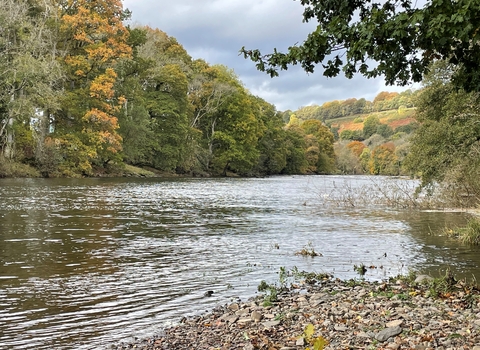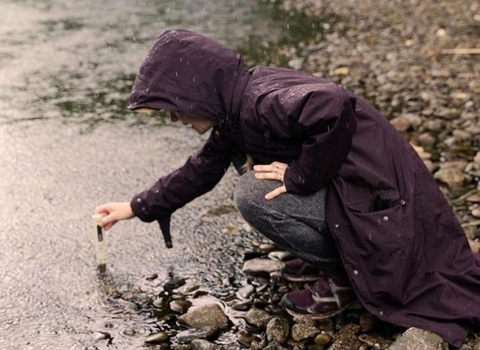Radnorshire is home to some of the UK's most magnificent rivers, the Lugg, Marteg and Ithon are all tributaries of the River Wye. Flowing from mid-Wales to the Severn estuary in England, it's one of the UK’s longest watercourses and is impacted by everything that happens in its large catchment. It's a Sites of Special Scientific Interest (SSSI) which should afford it the highest environmental protections. However, it has suffered from years of pollution from agricultural runoff from Intensive Poultry Units (IPUs) and other high stocking density farms, which has seen its waters coloured bright green from blooms of algae and its wildlife populations decimated, notably in key species such as the Atlantic salmon and white-clawed crayfish, as well as aquatic plants such as water crowfoot.
Powys now has more than 150 IPUs, housing an estimated 10 million chickens at any given time. This is industrial scale agriculture with factory-like production lines of, in some cases, 100,000 plus birds at each IPU site, making Powys Europe’s largest producer of free-range eggs. Birds are fed concentrated diets, often consisting of soya, much of which is from South America and grown on cleared rainforest.
High stocking density of sheep and cattle, not just chickens contributes heavily to runoff. The agricultural intensification that has taken place over the last few decades means the catchment is increasingly vulnerable to run-off, the landscape doesn't have the natural defences, and the phosphate load into our soil has grown.
What are we doing?
Radnorshire Wildlife Trust has been working hard for the many years to help bring attention to the devastation of the River Wye, mitigate the damage from agricultural runoff, and restore parts of this iconic river.
Campaigning for our rivers
Radnorshire Wildlife Trust started the Save the Wye campaign in 2020, and in the first phase over 5,800 messages were sent to Ministers for Climate Change and Rural Affairs, asking them to save the Wye. Then, an incredible 7,443 people took part in the second phase of our campaign, asking Welsh Government and Natural Resources Wales to work together to fund, resource and commit to an action plan to save the Wye. These efforts helped to put the River Wye on the agenda. In the most recent phase we gave supporters the opportunity to send a postcard to their Constituent Member of Senedd asking them to ensure that the Agriculture (Wales) Bill helps to deliver the essential change needed on the Wye. A total of 106 postcards were sent directly to the door of MS's.
In the Autumn of 2022, Radnorshire Wildlife Trust collaborated with Herefordshire Wildlife Trust on a River Wye Audit, collecting feedback from the public on what most concerns them about the state of the Wye and what action they would like to see next.
We received a great response to the River Wye Audit from 17-year-old volunteer for Herefordshire Wildlife Trust, Megan.
Monitoring our rivers
Citizen Science monitoring of our rivers by taking water samples is essential to identify pollution hotspots. Radnorshire Wildlife Trust works hard to support organisations Friends of the Wye and Friends of the Lugg to monitor and protect our rivers. We employ a programme manager on behalf of Friends of the Upper Wye, as well as providing Health and Safety and insurance coverage. We have seen an an incredible number of volunteers mobilised to take action for the River Wye and Lugg, which helps identify pollution hotspots and use that information to drive change to clean up our rivers.
Get involved: Citizen science — Friends of the Upper Wye (fouw.org.uk)
Restoring our rivers
Radnorshire Wildlife Trust currently has two ongoing projects to help restore our rivers and their surrounding catchments:
Wye Adapt to Climate Change?
Our staff on this project work with landowners to explore nature-based solutions to impacts from climate change such as holding water in the landscape to use for irrigation of agricultural land and prevent flooding of housing and businesses. The project will promote the creation of community climate action networks to support local communities in making positive changes to adapt to the effects of a changing climate, such as reduced food production, a decrease in crop resilience, loss of wildlife in once thriving habitats, algae blooms in our rivers and widespread flash flooding.
We are working in partnership with Herefordshire Wildlife Trust and the Wye Valley Area of Outstanding Natural Beauty (AONB) partnership on this programme.
Want to get involved? Contact Sarenta King, Wye React to Climate Change? Project Officer: sarenta@rwtwales.org
Wilder Lugg
Our staff on this project identify areas along the upper River Lugg within Radnorshire for flood mitigation and restoration, principally through riparian buffering (wetlands, uncultivated strips, and riverside tree planting), water monitoring to identify problems and opportunities and natural flood management measures, such as leaky dams, scrapes, and pools. We work to help the farming community who own land within the river corridor to position themselves for the incoming Sustainable Farming Scheme, the changing economics of land management and food production and the demands of climate change.
We are working in partnership with Herefordshire Wildlife Trust who also have funding for work on the Lugg catchment.
What needs to be done?
The Wildlife Trusts hosted a Wye Roundtable in Hay-on-Wye on the 17th July 2023. Chaired by Wildlife Trust CEO, Craig Bennett, national and local stakeholders including public bodies, environmental NGOs, farming networks and supermarket representatives came to a consensus that the current pollution pressures upon the River Wye was unacceptable. They discussed what steps needed to be taken to solve the challenges facing the Wye.
- A Refreshment of Catchment Governance. Multiple groups and initiatives are already active in the catchment but there is a lack of clarity over whether and how these interact, how duplication can be avoided, how trust and transparency can be developed, and how to gauge the collective impact of action. Current governance arrangements are not adequate and we wish to see senior political and community leadership, transparency of decision-making and a structure and process that can identify and drive forward immediate action.
- Ensuring plans add-up. Multiple plans exist across the catchment, and it's unclear whether these collectively add up to a level of delivery that would enable key targets to be met. Currently, plans lack the level of certainty required to be confident that their ambitions will be achieved, and the monitoring and reporting is insufficient to enable stakeholders to understand the scale and impact of action, and to inform further delivery. We wish for any reshaping of plans to take this into account.
- Frame solutions around the RePhoKUs recommendations. Placing the recommendations in the centre of any future plans will help create the necessary focus and ambition. We believe there is a need to reduce the phosphate input, particularly from agriculture, and that this will best be achieved through a combination of processing manure to produce renewable fertilisers, exporting phosphate products out of catchment, and reducing animal numbers.
- Prioritise (and fund) solutions. There are many solutions that could deliver mitigation and restoration in the Wye catchment, and there is a need to prioritise these various solutions and ensure that funding sources (both statutory and corporate) are most effectively targeted towards delivering the highest priority actions.
- Develop and support Farm Clusters. Supporting farmers on the ground to facilitate change is essential in restoring the Wye. Farm cluster groups which bring farmers together, showcase best practice and innovation, and share solutions to common issues through peer-to-peer learning have been shown to be effective in scaling up action on the ground, and enabling faster change.
These points were complied and sent to the ex-Secretary of State for Environment, Food & Rural Affairs, Thérèse Coffey, in a letter by Craig Bennett titled "The declining state of the River Wye". We are still waiting on a Plan for the Wye, and we hope and will do everything in our power to ensure these points are included.


